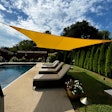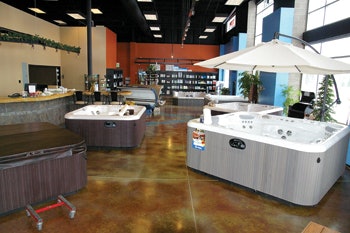 The showroom floor at Northwest Hot Springs in Ferndale, Wash. (Photos courtesy of Northwest Hot Springs.)
The showroom floor at Northwest Hot Springs in Ferndale, Wash. (Photos courtesy of Northwest Hot Springs.)
As much as we say otherwise, looks are important. Your store's design, from layout to lighting and the color on the walls, has the power to make your customers feel welcome, encourage exploration and even increase sales.
Few understand that power better than Brian Dyches, international chairman of the Retail Design Institute and chief experience officer for Ikonic Tonic. An expert in retail design with nearly 25 years of experience under his belt, including experience working one-on-one with pool and spa retail stores, Dyches says you can boost your bottom line by taking a more psychological approach to your store's design and appealing to the senses.
How can you change your retail design to influence your customers to buy more — and feel good about doing so? Dyches shares his tips below.
Layout
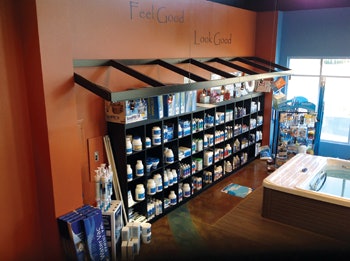 Aqua and sienna colors on the wall add visual interest and tie into the brand's color story. Shelves against a back wall are stocked, but not stuffed with product — and leaving spaces between gives product a more boutique feel.
Aqua and sienna colors on the wall add visual interest and tie into the brand's color story. Shelves against a back wall are stocked, but not stuffed with product — and leaving spaces between gives product a more boutique feel.
Customers are intuitive. After they've crossed the threshold of your store, it only takes a few moments for them to know if they're in for an outstanding (or below average) shopping experience — and it all begins with layout. How do you know what vibe your store emits?
"Take a picture 45 degrees to the left of where you're standing, straight on, and 45 degrees to the right," Dyches says. "Those three viewpoints are the three ways your store either feels like it's reaching out and giving you a big handshake or it's not."
What you're looking to provide, Dyches says, is guidance.
"If you don't give them a visual cue or clue to move forward with an engaging display, color or lighting, then customers wonder, 'Which way do I go?' And when customers feel misdirected, their experience or expectations begin to collapse," he says.

In the flow of your show floor, one common trouble spot Dyches finds in pool and spa retail stores is the hot tub display.
"Retailers take all the spa models and line them up like a police lineup," Dyches says. "And you know what, with all of their features and benefits, we know they're not all created equal."
If you have a large selection of hot tubs and space restrictions that require you keep them in a tight space, this one change makes all the difference:
"If you simply angle the spas instead of having them straight and pushed up against the wall, people will move closer in to the spas and begin to touch and interact with them."
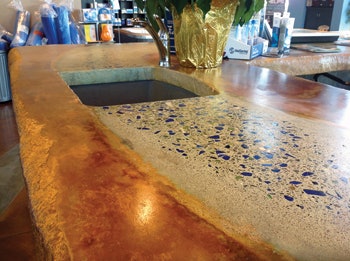
In addition to considering the positioning of your hot tub selection, Dyches says you should also think about how your hot tub displays work with (or against) your customer's expectations of the hot tub experience. For example, given that hot tub use typically involves swimsuits, family and close friends in a small space, customers associate it with a sense of privacy and intimacy. However, this notion can be contradicted by a lineup of hot tubs on your showroom floor.
"It looks too out-of-context," Dyches says.
To counteract that impression, Dyches suggests you take a page from IKEA's book.
"Put surrounds in-between to create little vignettes," he says. "Think of IKEA and how they break things into vignettes — they realized if you give customers appetizer pieces, they're going to consume more mentally.
"It's the same thing in a pool and spa store. If you want customers to really take it in, you've got to give them bite-sized pieces, not a 32-oz. piece of steak."
Lighting
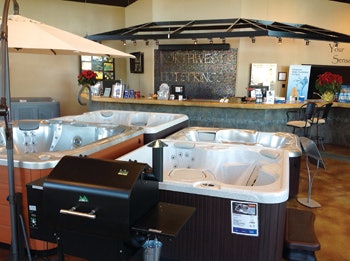 An angled hot tub selection allows customers to get up close with each model.
An angled hot tub selection allows customers to get up close with each model.
As a specialty retailer, you have the opportunity to use your store's appearance to differentiate yourself from big box stores. Lighting is a key way to accomplish this.
"A mass retailer's goal is to create an even swath of light through the entire store because it makes it easier on their operations and maintenance departments," Dyches says. "As a specialty retailer, you have to realize that lighting, especially when you're selling expensive items, has a lot to do with building that price value perception."
One industry that uses lighting to its advantage: the jewelry industry. In the same way jewelers use lighting to emphasize the sparkle of a diamond, so too can you make a hot tub sparkle in the eyes of your customers.
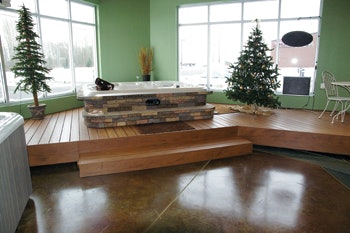 A deck installation in a corner of the store creates a vignette that customers can relate to.
A deck installation in a corner of the store creates a vignette that customers can relate to.
"The spa industry has done a lot in the last 20 years to really study ergonomics and really understand body shapes. That's really the spa industry's sparkle factor: all these great features and accouterments that go with these products."
While lighting can emphasize the artistry of a hot tub model, it can also have a very real impact on your bottom line.
"You can affect price value by up to 20 percent with incorrect lighting," Dyches says. "If you're into giving someone a 20 percent discount on a $4,400 item, go for it. But spend a couple hundred dollars on better lighting, and all those $4,400 items look like they should be $5,000."
Sound and Color
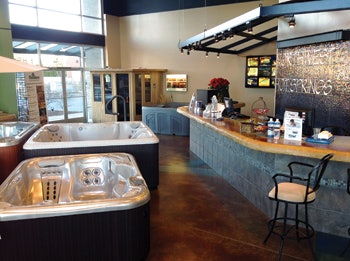
What's playing in the background while your customers shop? If it's the latest hits on the Top 40 charts, you should reconsider.
"It's important to recognize that when you're playing music in a retail environment that has lyrics, you're inviting the processing ability of the human brain to be distracted from the marketing message that you're really intending," Dyches says. "Instrumental music is always the better choice because it has familiar tones and goes deeper into the cortex."
Color can have a profound effect on the shopping experience, too, and Dyches says you can harness that power in your retail space. To start, visit model homes in your area. Why? They're carefully decorated with color and design trends in mind, which you can mimic in your store environment.
"Ultimately, you're selling a spa that's going to go with someone's home, so you want it to feel at home," Dyches says. "You want it to feel like it fits in."
Even more importantly, peeking into model homes will clue you in to what colors are popular on a local level.
"Regional colors have a lot to do with the feeling people get in an environment," Dyches says. For example, a business in the Pacific Northwest might consider adding deep blues and greens to their retail environment, while a business in a historically-rooted city, like Philadelphia, may benefit from more rustic colors.
It also helps to study up on the basics of color theory.
"Bright colors like orange or red are action colors," Dyches says. "Those tend to help push customers to a higher degree of excitement and frankly, toward 'getting it done.' Red is often used in retail, especially in artwork or in one or two colors near change rooms, because it's been proven that more people will buy garments after seeing red."
There's no right or wrong answer for your color choice. The goal, Dyches says, is to take all these elements into consideration and create a "family of colors" that makes your brand feel authentic.
Smell
Dyches says our sense of smell is one of our most powerful senses. And as an industry professional, you probably understand how that affects the pool and spa retail environment.
"Think about it: you're trying to sell someone on a spa. Customers are smelling all those chemicals, and what is it doing? It's reminding them they've got to spend more money to maintain it," he says.
To counteract this, skip the candles and Febreeze. Instead, Dyches suggests looking into a company like Scentair, which crafts scents for the retail environment.
"There definitely is, and always has been, scientific proof that creating pleasant-smelling environments — with pine scents, apple, seasonal scents, lemon scents — calm consumers and allow them to be more open to your marketing messages."
These powerful background scents are almost undetectable, he says.
Overall, the key to successful store design lies in how you use your space to tap into your customer's mindset.
"That's what great retail design is all about: using known behavioral characteristics of the consumer and making sure you're not only using them, but you're using them well," Dyches says.
Comments or thoughts on this article? Please e-mail [email protected].


























![CK Spas has aimed to create an experience and not just an ordinary store, to inspire and make customers feel at home [see tip No. 41]. 'I know we've accomplished this when people walk in, stop and smile,' says Owner Dana Hyde. 'It also makes for a great work environment that is warm and cozy.'](https://img.aquamagazine.com/files/base/abmedia/all/image/2023/01/3B_223_AQ_C1_Header1_lg.63c84d226b28f.png?auto=format%2Ccompress&fit=crop&h=167&q=70&w=250)




